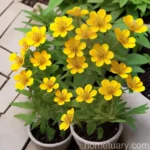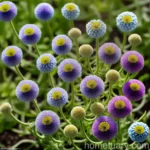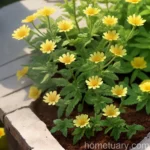The Wonderful World of Patrinia (Patrinia scabiosifolia)
Welcome to the fascinating world of plants, where we will explore the wonderful Patrinia (Patrinia scabiosifolia). In this extensive guide, we will delve into its culture, uses, care requirements, propagation, common diseases, pests, and much more. So, let’s embark on this botanical journey together!
What is Patrinia (Patrinia scabiosifolia)?
Patrinia (Patrinia scabiosifolia) is a charming and versatile perennial plant that belongs to the honeysuckle family, Caprifoliaceae. It is native to East Asia, particularly Japan, Korea, and China, and has made its way into gardens around the world due to its attractive appearance and numerous beneficial properties.
This herbaceous plant is characterized by its delicate, bright yellow, star-shaped flowers that bloom atop slender stems from mid-summer to early autumn. The foliage is also quite appealing, with deeply toothed leaves adding to the overall attractiveness of the plant.
Key Takeaways
- Scientific Name: Patrinia scabiosifolia
- Family: Caprifoliaceae
- Native to: East Asia
- Bloom Time: Mid-summer to early autumn
Now, let’s jump into the essential aspects of caring for Patrinia, from its cultural requirements to its uses and care guidelines.
Culture
Water
Patrinia thrives in well-draining soil and generally prefers consistently moist conditions, especially during the growing season. However, it is crucial to avoid waterlogging, which can lead to root rot and other issues. When watering, aim to keep the soil consistently moist but not waterlogged.
Sunlight
This plant flourishes in full sun or partial shade. In regions with hot summers, providing some afternoon shade can prevent the plant from becoming stressed and helps maintain the quality of its blooms and foliage.
Soil
Well-draining, fertile soil is ideal for Patrinia. A loamy soil with a slightly acidic to neutral pH (around 6.0 to 7.0) is preferred. Amending the soil with organic matter can improve its structure and nutrient content, promoting healthy growth.
Fertilizer
Applying a balanced, all-purpose fertilizer in spring as new growth emerges can assist in promoting vigorous blooming and robust foliage. Always follow the manufacturer’s recommendations for the specific fertilizer being used, and avoid over-fertilizing to prevent potential issues.
Pruning
As the blooming period comes to an end, it’s beneficial to deadhead the spent flowers to encourage additional blooms and maintain the plant’s overall appearance. In late fall or early spring, it is advisable to cut back the stems to ground level to rejuvenate the plant for the coming growing season.
Uses
- Ornamental: Patrinia is highly valued for its ornamental presence in gardens, particularly in cottage gardens, perennial beds, and rock gardens. Its bright yellow flowers add a pop of color to the landscape, and the plant’s overall form and foliage provide visual interest throughout the growing season. In addition, it can be used as a cut flower in floral arrangements.
- Medicinal: In traditional medicine, Patrinia has been used for its purported medicinal properties. However, it is crucial to consult with healthcare professionals before using any plant for medicinal purposes.
Propagation
Patrinia can be propagated through several methods, including division, cuttings, and seed sowing. Let’s dive into these propagation techniques:
Division
Dividing established clumps of Patrinia every few years in early spring, just as new growth begins, can rejuvenate the plant, prevent overcrowding, and promote healthier growth. When dividing, ensure that each division has healthy roots and shoots to support its growth.
Cuttings
Taking stem cuttings in early summer and rooting them in a well-draining soil mix can be an effective way to propagate Patrinia. By providing the appropriate growing conditions and care, the cuttings can develop into healthy, independent plants.
Seed Sowing
Collecting and sowing seeds from mature Patrinia plants can also lead to successful propagation. Sow the seeds in a well-prepared seedbed or containers, and provide the necessary warmth, moisture, and light for successful germination and growth.
Container Popularity
Patrinia’s compact growth habit and attractive appearance make it well-suited for container gardening. When choosing a container, ensure it has ample drainage holes to prevent waterlogging, and use a high-quality potting mix that provides the necessary nutrients and good drainage. Regular monitoring of moisture levels and watering as needed are crucial for the well-being of Patrinia in containers.
Common Diseases
While Patrinia is generally resilient, it can occasionally be susceptible to certain diseases. Being aware of these potential issues and taking preventive measures can help maintain the plant’s health. Some common diseases include:
-
Powdery Mildew: This fungal disease can appear as a powdery, white substance on the leaves, affecting the plant’s overall health and appearance. Proper air circulation and avoiding overhead watering can help prevent powdery mildew.
-
Crown Rot: Excessive moisture or waterlogging can lead to crown rot, which affects the plant’s base and can ultimately result in its decline. To prevent this, ensure that the soil has adequate drainage, and avoid overwatering.
-
Leaf Spot: Leaf spot diseases can cause unsightly blemishes on the foliage. To mitigate leaf spot, focus on providing good air circulation and proper spacing between plants, and avoid overhead watering.
Disease Diagnosis
When diagnosing potential diseases affecting Patrinia, carefully observe the plant for any signs or symptoms such as unusual spots, discoloration, or wilting. It is advisable to consult with local agricultural extension services or experienced gardeners to accurately identify any diseases or issues and determine the most appropriate course of action.
Common Pests
While generally resilient to pests, Patrinia can occasionally encounter pest issues, including:
-
Aphids: These small, soft-bodied insects can cluster on the new growth and underside of leaves, leading to distorted growth and potential damage. Regularly inspect the plant for aphids and consider using natural predators, such as ladybugs, or environmentally friendly pest control methods if intervention is needed.
-
Spider Mites: These tiny pests can cause stippling and webbing on the foliage, impacting the plant’s health. Monitoring the plant for any signs of spider mite activity and using methods such as spraying the foliage with water or employing natural predators can help manage these pests.
Botanist’s Tips
- Regular monitoring: Keeping a close eye on the plant for any signs of stress, disease, or pest activity can help address issues promptly and maintain the plant’s overall health.
- Adequate support: Providing physical support, such as stakes or rings, can help prevent the plant from flopping over or becoming damaged, especially as it grows and produces flowers.
Fun Facts
-
In traditional Asian medicine, certain species of Patrinia have been utilized for their potential medicinal properties, though it’s important to note that the efficacy and safety of herbal remedies should be thoroughly researched and confirmed by medical professionals.
-
The bright yellow flowers of Patrinia serve as a valuable nectar source for pollinators such as bees and butterflies, contributing to the biodiversity and ecological balance of the surrounding area.
-
Some varieties of Patrinia and its close relatives are used in traditional landscaping and as part of herbal gardens in their native regions, reflecting the cultural significance and aesthetic appeal of these plants.
Now that we’ve explored the essentials of Patrinia’s culture, uses, and care requirements, it’s time to delve deeper into the wealth of knowledge surrounding this remarkable plant.
References
- Burke’s Backyard, Patrinia scabiosifolia – How to grow
- Plant Delights Nursery, Patrinia scabiosifolia Care Guide
- Fine Gardening, Patrinia scabiosifolia
In the next section, we’ll continue to explore the wide-ranging facets of Patrinia, including its varieties, medicinal uses, soil requirements, and more.















